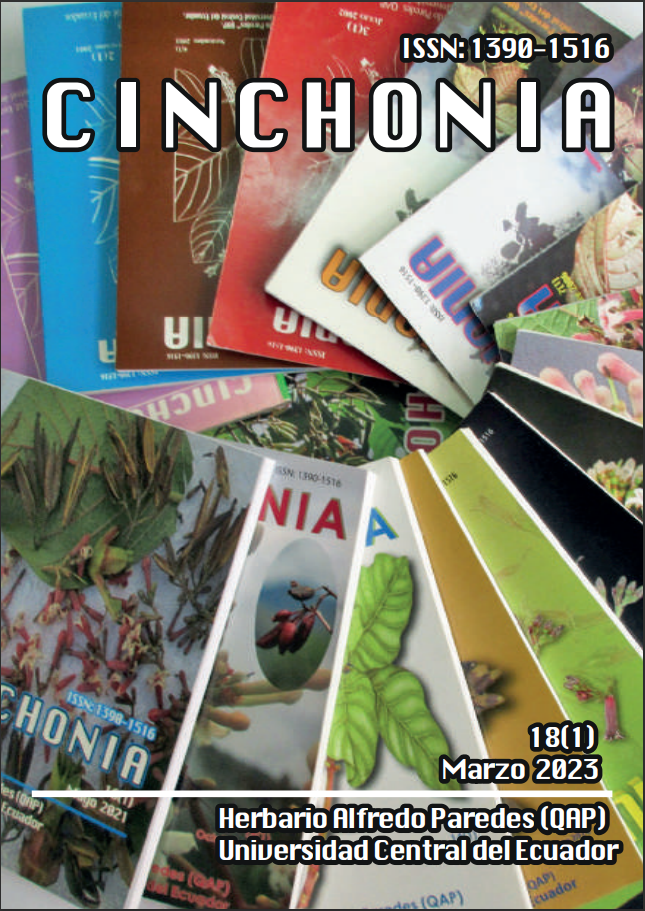Plants of the Municipal Cemetery La Merced, Ambato, Tungurahua-Ecuador
Main Article Content
Abstract
The oldest Municipal Cemetery in the city of Ambato is located in the neighborhood of La Merced, with an approximate extension of 2 hectares, it has the category of patrimonial, it includes in its interior: constructions of niches in rows and sepulchers at level and under the ground, where the remains of important characters of Ambato’s history rest. In 2014 and 2022, by means of photographs and a few herborizations, an inventory of the plants present in the cemetery was made. The results indicate that the cemetery is ornamented by an important dynamic flora (187 species), most of which are introduced (150), native (35) and endemic (2), cultivated and ruderal; between 2014 and 2022, there was a decrease of half of the plants and in similar number their replacement.
Article Details

This work is licensed under a Creative Commons Attribution-NonCommercial-NoDerivatives 4.0 International License.
References
Acosta Solís M (1962) Flores y plantas
ornamentales de la tierra ambateña,
instituto Ecuatoriano de Ciencias
Naturales, Quito.
Barallat C. y Falguera (1885) Principios
de botánica funeraria. Tipo-litografía
de Celestino Verdaguer, BarcelonaEspaña.
Berg C.C. (1999) Moraceae. Pp. 604-
En Jorgensen P.M. & S. LeónYánez (eds.). Catalague of the Vascular
Plants of Ecuador. Missouri Botanical
Garden Press, St. Louis, MissouriU.S.A.
Bocchio Pérez D.P. y C.F. Lino Zanoni.
(2017). Turismo funerario: caso
cementerio de Miraflores, parte antigua,
Trujillo – Perú. Tesis en Licenciatura en
Administración y Servicios Turísticos,
Facultad de Negocios, Universidad
Privada del Norte, Trujillo-Perú.
Brickell C. & J.D. Zuk (1997) A-Z,
Encyclopedia of Garden Plants. The
Americanm Horticultural Society,
Dorling Kindersley and New York,
U.S.A.
Caicedo Cepeda G (2014) Diseño de
una guía interpretativa de especies
útiles de flora del Jardín Botánico la
Liria, Ambato, Tungurahua. Tesis de
Licenciatura en Turismo Ecológico,
Facultad de Ciencias Agrícolas,
Universidad Central del Ecuador, Quito.
Cañadas Cruz L (1983) El mapa
bioclimático y ecológico del Ecuador.
MAG-PRONAREG-Banco Central del
Ecuador, Quito.
Carta Internacional de Morelia (2006)
Apuntes 18(1-2): 154-157.
Cerón Martínez CE (2011) Flora
Funeraria del Cementerio Municipal de
Píllaro, Tungurahua, Ecuador. Memorias
de XXXV Jornadas Nacionales de
Biología y I Congreso Ecuatoriano de
Mastozoología. Sociedad Ecuatoriana
de Biología, Núcleo de Pichincha y
Pontificia Universidad Católica del
Ecuador, Quito. Págs. 72-73.
Cerón C., R. Riina y J. Santiana.
Euphorbiaceae. Pp. 317-325. En: LeónYánez S., R. Valencia, N. Pitman, L.
Endara, C. Ulloa Ulloa y H. Navarrete
(eds.) (2011) Libro Rojo de las plantas
endémicas del Ecuador. 2da. Edición.
Publicaciones del Herbario QCA,
Pontificia Universidad Católica del
Ecuador, Quito.
Cerón Martínez C.E. (2015) Bases para
el estudio de la flora ecuatoriana. Edit.
Universitaria, Quito.
Cerón-M C-E. (2015). La flora en los
cementerios patrimoniales del Ecuador.
Memorias del III Congreso Boliviano
de Botánica, Ediciones IASA, SucreBolivia.
Cerón Martínez C. (2018a) Las plantas
en los cementerios de Andahuaylas,
Ayacucho, Cusco y Lima, Perú. En
Libro de Resúmenes del XVI Congreso
Nacional de Botánica, Universidad
Nacional San Cristóbal de Huamanga,
Ayacucho-Perú. Pág. 93

